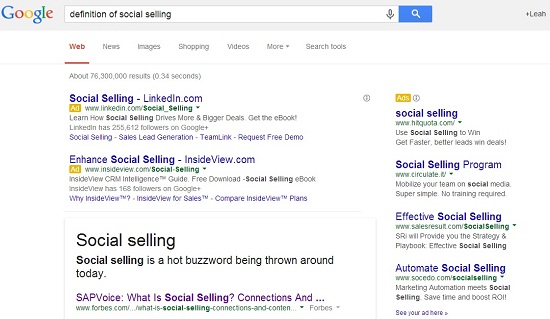 According to the Google results below, social selling is “a hot buzzword being thrown around today.” I agree with this sentiment.
According to the Google results below, social selling is “a hot buzzword being thrown around today.” I agree with this sentiment.
But what is social selling and how can it affect your business? Social selling is using your online presence to make connections and share content that enhances your personal (and company) brand. Some tactical examples include writing industry-specific blogs and posting that content on your LinkedIn profile, following and engaging with prospects on Twitter or joining relevant online groups to answer questions and share valuable content.
One challenge in nailing down a definition is that selling is social by nature. Tom Gimbel, CEO of LaSalle Network, believes that “social selling (or recruiting) is an extension of the core activities and tasks associated with building relationships.” Aaron Zeper, VP of sales, marketing and professional services at Signature Technology Group, echoes this position, “Selling is social by nature. Use social selling to increase the volume of the relationships and interactions you can have, but the best interactions are more personal.”
Social selling and the staffing industry
So why is social selling getting so much attention, and how does it relate to the staffing industry? I’ve asked three industry leaders to share their experiences and provide insight into how your organization can leverage this trend to drive revenue:
1. Identify what social selling means to your company and determine your goals. Donna Carroll, VP, North America, Global Staffing Services for CDI Corp., points to the important distinction in the staffing industry that “sales” extends beyond account executives. “First, I think you have to look at everyone being a ‘salesperson’. It is not just the traditional salesperson that is client-facing, but the recruiters as well,” she says. Identify what social selling means to both recruiters and salespeople at your company and consider how each can benefit from connecting with their target audiences online. For example, does social selling mean that your recruiters should spend time writing blogs and sharing this content OR will your marketing teams feed them content that they can share across their online platforms to help attract candidates?
Going hand-in-hand with identifying the right approach for social selling is outlining your goals. Zeper shared, “It’s common for organizations to do things that don’t directly relate to the metrics that the business cares about. I always ask my teams: why? Why do you want to drive traffic to our website? Why is social selling necessary? These types of questions help align both marketing and sales efforts to business results.”
PREMIUM CONTENT: Legs & Regs Advisor, North America
2. Provide training and tools to get buy-in. Since new social tools are constantly emerging and evolving, it’s important to train your teams on your approach to social selling and how to use the tools available to them.
For instance, LaSalle Network includes training on using social media during their onboarding programs for new employees. Many firms are also investing in tools that foster and incorporate social outreach, like ATS and CRM systems that distribute jobs to social platforms or append candidate or prospect records with social profiles. Carroll mentioned that “As an organization, CDI will continue to look for new trends and technologies that will enable it to provide faster service to clients, with an emphasis on quality.”
Investing in the right tools and training is one critical step to getting buy-in. In Zeper’s experience, “Buy-in from internal teams is necessary for adoption and greater ROI. Adoption of social selling techniques has varied but I encourage teams to learn new things, especially as Twitter has become more business-focused.”
3. Monitor results and share success stories. Carroll notes that her organization and other staffing firms are seeing very real gains through quicker sales cycles by adopting social selling, “The ability to tap into professional networks like LinkedIn, target key decision makers within a company and begin to have meaningful business conversations not only expedites the sales cycle, but allows clients and prospects to participate in real-time collaboration.”
But buy-in from salespeople and recruiters is a continual process. Excitement fades as the novelty factor wears off – especially if no one sees that social selling is actually working for them or their peers! Continually monitor results and share success stories. For example, has a recruiter been successful in connecting with candidates via Twitter? Or does one salesperson use LinkedIn to land all of his or her meetings? Sharing these lessons can help spark more interest from peers.
When you’re monitoring, you can also quickly adjust and recognize successes. Zeper shared that he monitored usage and when people weren’t taking advantage of the tools, he reallocated those licenses to others within the organization that preferred to engage in online professional networking for better results. At LaSalle Network, Gimbel focuses heavily on recognition. “If people aren’t incentivized and motivated by the culture, they aren’t going to work toward the goals regardless of whether they are engaging in social selling or attending a live networking event.”
As the candidate market tightens and competitive pressure increases, social selling is another opportunity for staffing firms to connect with their audiences. Focus on going beyond the “buzzword being thrown around” to launching and monitoring a social selling initiative that complements existing efforts and delivers results.










[…] MORE: Lessons on social selling from industry leaders […]
[…] Read this full article on Staffing Stream. […]